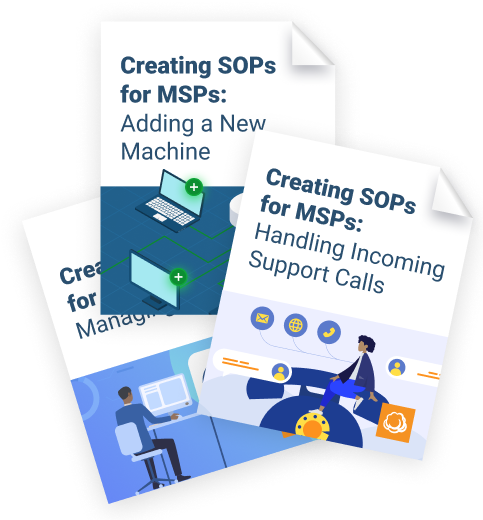The global market for managed services is expected to reach $282 billion by 2023. But not all MSPs will reap the benefits equally. Why? Because not all providers are the same. MSPs come in different sizes and shapes with separate client profiles and backgrounds.
Know Your MSP
As an MSP owner, you need to understand your position in the market. This information will help you enhance your service and product offerings, as well as marketing and sales activities.
Recognizing the maturity level of your MSP business helps prioritize your technology requirements, both at present and in the future.
Find Out More About MSP Categories
Most MSPs can broadly be divided into four distinct tiers:
Tier 1: Small Business
Tier 2: Midmarket and Enterprise
Tier 3: Telcos and Cloud Service Providers
Tier 4: Global Systems Integrators and IT Consulting Firms
Each tier offers services, but caters to a certain group of customers and comes with its own set of needs.
Tier 1: Small Business MSPs
These IT service providers monitor and manage client networks remotely and shift customer workloads to third-party cloud providers, such as Amazon Web Services, Microsoft Azure and Google Cloud. According to ChannelE2E, there are fewer than 20,000 successful small business MSPs in the US market.
Tier 1 MSPs normally work with approximately 10 clients. Although they may have a couple of managed contracts, they focus mostly on the break/fix model.
Further reading How to Transition Your Break-Fix Clients to Managed Services
Due to the unpredictable income and uncertain revenue, these MSPs often skip tool and infrastructure investments. This results in less efficient, homegrown customer support solutions.


Tier 2: Midmarket and Enterprise
These companies have between five to twenty employees and a single founder. However, they still manage to generate annual revenue of $1.5 million to $5 million, and have 500 to 2,500 endpoints under their management.
These MSPs mostly work side-by-side with corporate IT firms, offering proactive, remote services like account management, remote support, installations, backup and IT security services.
These mid-level MSPs take more responsibility for a client’s business. Although most Tier 2 MSPs rake in a steady source of revenue, some manage to grow by developing expertise in certain areas or differentiating themselves from the competition.
In this package, you will get five guides helping to create marketing strategies and tips on:
- Dealing with on-site SEO
- Creating web advertising properly
- Email chains for MSPs
- Content marketing for an MSP blog
- Social media marketing
Tier 3: Telcos and Cloud Service Providers
Tier 3 MSPs differ from the previous two tiers. These firms are actual technology service providers that focus on professional and managed cloud services.
Earning a yearly revenue ranging from $5 million to $20 million from a diversified client base, these MSPs have 20 or more employees spread across various divisions. Most importantly, all of their functions are growth-oriented.
These MSPs include industry giants like Microsoft and Amazon, who integrate managed services into their hosted and cloud services. Rackspace, for example, has maintained its own cloud since mid-2015, offering managed services for Microsoft Azure.
These businesses provide customized services: Along with providing complete IT operations, they offer lower levels of service and specific types of expertise. The options they provide mostly depend on the customer's budget.
The goal of these companies is to increase monthly recurring income, which grows via geographic expansion and acquisitions.
Further reading MSP Mergers and Acquisitions
Tier 4: Global Systems Integrators and IT Consulting Firms
These enterprise-class managed services are the largest MSPs. They earn over $25 million every year and have a large staff on their payroll. Almost one-third of their business comes from projects instead of ongoing services, and they normally compete with tech giants like IBM and Wipro for clients. These MSPs grow through acquisitions.
Moving from One Level to the Other
As an MSP business owner, you should always focus on current needs. Rely on your present revenues and stick to your company’s financial standings to enhance functionality and reach success.
Moving from Tier 1 to Tier 2
Small MSPs should minimize break/fix contracts and buy into modern RMM and PSA solutions. The latter will allow them to automate more tasks and streamline processes. This leads to more effective operational and business processes which in turn leads to bigger profits.
Moving from Tier 2 to Tier 3
Tier 2 MSPs are all about scalability and providing high-quality services while growing the number of endpoints under management. You should focus on tools that immediately address customers’ needs and distribute revenue to promote future growth.
Moving from Tier 3 to Tier 4
Tier 3 MSPs rely on efficient staff and operations to sustain high margins and rapid growth rates. Arrange simultaneous communication of departments and pay even more attention to sales and technical teams.
Further reading Guide to Managing Your MSP Sales Team
Choose Your Priorities Well
Think about what sort of MSP you are and what functionalities and features you should pursue to address your company’s present and future needs. Prioritize the items by getting what you need and avoiding what you don’t for efficient growth.







